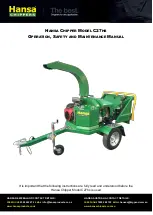
19
Step 3 — Complete Refrigerant Piping
GENERAL — All field leak and pressure testing should be in
accordance with local code requirements. If a local code does
not exist, use ASHRAE (American Society of Heating, Refrig-
erating, and Air Conditioning Engineers) Standard 15, Safety
Code for Mechanical Refrigeration.
For leak testing procedures, refer to the Carrier “Refrigerant
Service Techniques” book, Form SM-1A.
Perform phos-copper brazing on all field-made connections
while protecting adjacent joints from heat.
Install or replace filter driers.
If the chiller is above the condensing unit, the maximum al-
lowable vertical separation between the condensing unit and
the evaporator. See Liquid Lift section on page 21.
Relieve the pressure caused by the nitrogen holding charge.
Connect liquid line and discharge line to field piping. Refer to
Fig. 5-9 for circuit orientation. Hot gas and liquid connections
are located on the same end of the uit and are sealed with tube
plugs.
Units are shipped standard with fan cycle pressure switches
for use with R-410A refrigerant. Carrier 30HXA units are
shipped with fan cycles pressure switches for use with R-134a
condensing units.
Fan cycle pressure switches are to be installed on the dis-
charge lines. Do not remove Schraeder valves from fittings.
See Fig. 13-15 for unit piping. See Fig. 16 for switch details.
A tubing package for converting dual circuit units into sin-
gle circuit units is shipped with all 09DP035-130 units. The kit
is field installed. See Fig. 17.
The refrigerant system must not be opened and exposed to
atmosphere for longer than 15 minutes. Connection and pump-
down should be made as soon as possible to avoid acids
forming in the compressor POE (polyolester) oils, which could
damage the compressors.
Leak test the entire system by using soap bubbles and nitro-
gen and an electronic leak detector.
Purge nitrogen from system after completion of leak-check-
ing procedure. Repair leak if one is found. When finished,
evacuate and dehydrate system using the following method.
EVACUATION AND DEHYDRATION — Because the
30MPA and 30HXA systems use polyolester oil, which can ab-
sorb moisture, it is important to minimize the amount of time
that the system interior is left exposed to the atmosphere. Mini-
mizing the exposure time of the oil to the atmosphere will min-
imize the amount of moisture that needs to be removed during
evacuation.
CAUTION
Do NOT bury refrigerant piping underground. Failure to
comply could result in equipment damage.
CAUTION
The 09DP unit is shipped with a nitrogen holding charge.
Use caution when relieving unit pressure to avoid possible
equipment damage or personal injury.
IMPORTANT: Unit is compatible with various refriger-
ants. Ensure fan cycle pressure switches and Motormas-
ter
®
option are installed correctly per unit refrigeration
configuration.
IMPORTANT: Protect the liquid and suction service
valves from the heat of brazing. Schrader valve cores
must be removed from the liquid and suction service
valves before brazing in field connection piping to avoid
damage. Reinsert cores after brazing is completed.
MOTORMASTER
TRANSDUCER
LOCATION
Fig. 13 — Unit Piping — Sizes 018-030
a09-591
















































